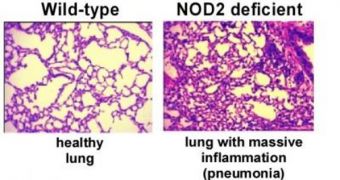Experts at the University of Texas Health Science Center in San Antonio (UTSC) have recently identified a new molecule that is able to detect two of the most common respiratory viruses. Upon detecting the pathogens, the structure is able to mount and coordinate an immune-system attack on the intruders and annihilate them. Details of the find appear online, in the August 23rd issue of the journal Nature Immunology, e! Science News reports.
The two organisms that the molecule can detect are the human respiratory syncytial virus (RSV) and influenza A, better known as the common flu. While they can be easily defeated by an adult's immune system, they pose serious challenges to seniors, small infants, and people with a weaker immunity. The new compound could be used to create a new series of vaccines against these viruses, which could destroy them a lot faster than existing medication can.
“This molecule could be used to boost host immune defenses and stimulate vaccine efficacy against RSV and influenza A, especially among high-risk individuals,” UTSC Assistant Professor of Microbiology and Immunology Santanu Bose, PhD, also the senior author of the new paper, explains. Other members of the research team have been graduate student Ahmed Sabbath and research scientists Te-Hung Chang and Rosalinda Harnack.
The molecule, which was named NOD2, proved to be extremely effective in mice studies. The animals that were genetically engineered to lack it survived for only ten days after infections, whereas those who had it lasted about eight weeks. The researchers say that the new defense mechanism could potentially be used to identify other pathogens as well, such as the West Nile virus, the yellow fever, Ebola and rabies. “In the future, studies will gear up to find out if NOD2 is a susceptibility gene for respiratory viruses, since frequent mutation of this gene has been found in humans,” Bose adds.
“This is a major breakthrough in understanding respiratory virus behavior and innate immune antiviral factors, and provides the basis for innovative therapies to improve host responses to infectious diseases,” UTSC Chairman of Microbiology and Immunology Joel Baseman, PhD, concludes.

 14 DAY TRIAL //
14 DAY TRIAL //